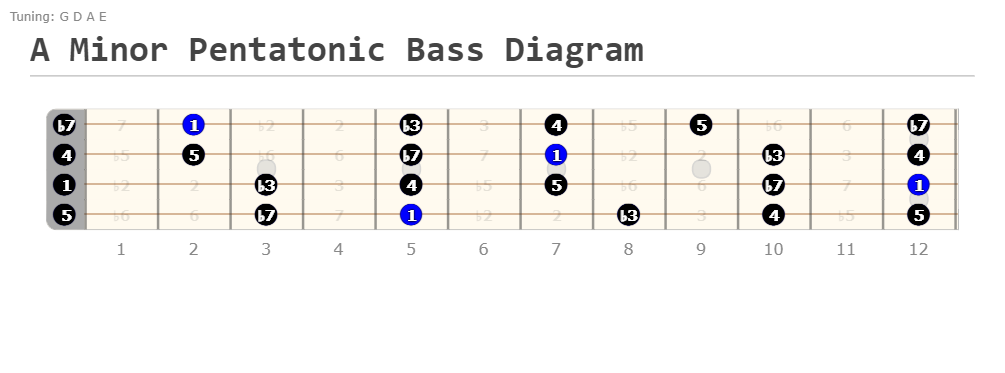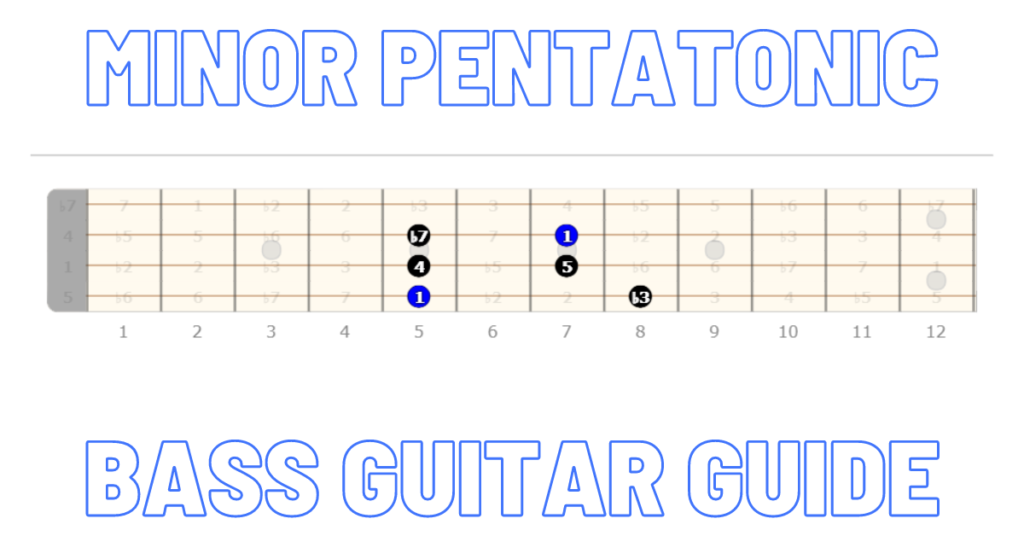In this minor pentatonic scale bass guitar lesson you’ll learn how to apply the scale and play it across the whole neck.
You’ll learn all 5 minor pentatonic scale bass shapes, how to apply the scale, the one-octave scale shape, and all the theory behind the minor pentatonic scale.
Let’s dive in!
Table of Contents
What is the minor pentatonic scale?
The minor pentatonic scale is one of the easiest bass scales to learn and apply. It’s used in virtually every genre, and has incredible potential for building killer bass grooves.
Due to the name, minor pentatonic, you can decipher that the scale has five tones.
Penta = 5 | Tonic = Tones
Due to a lack of common tension building intervals used in other minor scales, such as the b2 or b6, the minor pentatonic scale won’t interfere with the harmony in most musical contexts, and that’s what makes it so great!
All of these factors make the minor pentatonic scale one of the easiest bass guitar scales for beginners.
Minor pentatonic scale bass formula
The minor pentatonic scale is built using the following scale degrees:
1-b3-4-5-b7
The minor pentatonic scale is like the natural minor scale formula, but omits the 2 and b6 intervals.
Whole-step and half-step construction of minor pentatonic
The minor pentatonic scale has no half steps, which is key to its simple, tension-light sound.
Starting from the root note, minor pentatonic scale is constructed using:
W+H – W – W – W+H – W
One octave minor pentatonic scale bass shape
When applying the minor pentatonic scale formula it will result in this one octave shape.
Due to it’s popularity, we’ll be using the A minor pentatonic scale. It contains the notes:
A-C-D-E-G
I play the entire one octave pentatonic scale using my first (index) and fourth (pinky) fingers.

One octave minor pentatonic scale bass shape on a single string
Learning the minor pentatonic scale on a single string is the best way to understand it’s whole-step and half-step construction.
Pay attention to the sound from one note to the next, and take note of the lack of tension-building intervals.
Practicing scales on a single string is one of the best ways to train your ear, which will unlock and help you understand the unique sounds from the scales you are practicing.

All 5 minor pentatonic scale bass shapes
Learning all 5 minor pentatonic shapes in A minor will allow you to play the scale across the fretboard.
On top of this, learning all 5 shapes will make it easy to transpose the scale! That way you can play in multiple keys by learning just 5 shapes.
A Minor Pentatonic Shape 1

A Minor Pentatonic Shape 2

A Minor Pentatonic Shape 3

A Minor Pentatonic Shape 4

A Minor Pentatonic Shape 5

A Minor Pentatonic Fretboard Diagram
Looking at the complete A minor pentatonic fretboard diagram shows you how all 5 shapes come together to create one large fretboard map.

Practicing the minor pentatonic scale
Practice the A Minor pentatonic scale over an A minor triad or A minor 7th chord.
You can then transpose the scale and continue to play it over minor triads and minor 7th chords with the same root note.
It’s also important to practice the minor pentatonic scale and other bass scales by finding and learning popular songs that use the scale.
One of my favorite uses of the Minor Pentatonic scale for bass is in the song Low Rider by War! It uses G minor pentatonic, and the bass riff is funky, and luckily not too difficult.
You can also complement your minor pentatonic scale with blues notes. A blues note is simply a chromatic passing tone between the 4th and 5th interval.
Lastly, you can use backing tracks like this one to compose and improvise bass lines in A minor pentatonic. And if you’re feeling brave, you can practice the Dorian mode, which is a minor mode, over this backing track as well.
Until then, keep grooving!

